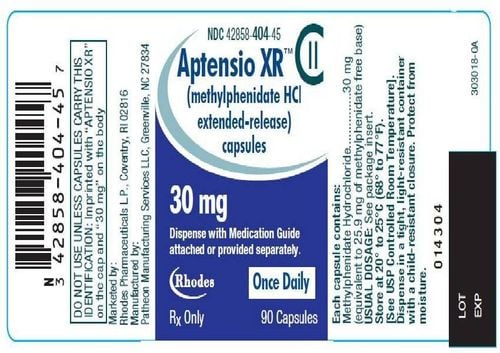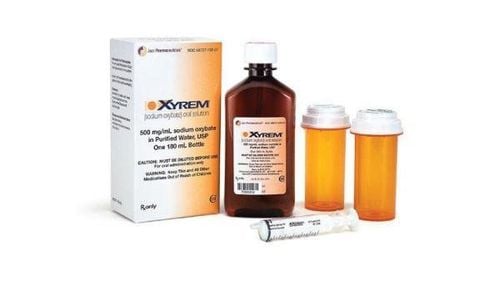This is an automatically translated article.
Wakix has the main ingredient Pitolisant hydrochloride, which belongs to the group of psychotropic drugs. Wakix is commonly used to treat cases of excessive daytime sleepiness (EDS) in adults with narcolepsy with or without Cataplexy. Basic information such as ingredients, uses, doses and unwanted side effects of Wakix will help patients and their families improve treatment results.
1. What is Wakix?
Wakix drug is made in the form of 5mg and 20mg film-coated tablets, with the main ingredients including:
Active ingredient: Pitolisant (in the form of Pitolisant hydrochloride) 4.5 mg or 18mg. Excipients: Colloidal Silicon dioxide, Crospovidone, Magnesium stearate, Microcrystalline Cellulose, Polyethylene glycol, Polyvinyl alcohol, Talc powder and Titanium dioxide just enough for 1 film-coated tablet 5mg or 20mg. Mechanism of action:
The mechanism of action of the active ingredient Pitolisant hydrochloride in Wakix on excessive daytime sleepiness (EDS) in adult patients with narcolepsy is unclear. Some theories suggest that Pitolisant hydrochloride is a potent orally active histamine H3 receptor antagonist that, through blocking histamine autoreceptors, enhances the activity of histaminergic neurons in the brain. brain, a system of extensive stimulation to the entire brain. Pitolisant hydrochloride also regulates various neurotransmitter systems, increasing the release of Acetylcholine, Noradrenaline and Dopamine in the brain.
2. What effect does Wakix have?
Wakix is indicated for the treatment of excessive daytime sleepiness (EDS) in adult patients with narcolepsy (Narcolepsy) with or without Cataplexy.
Excessive Daytime Sleepiness (EDS) is falling asleep or staying asleep during normal waking or waking hours. Narcolepsy includes symptoms associated with sleep disorders including daytime sleepiness, restless sleep, hallucinations, poor sleep, or body paralysis when sleep.
Cataplexy symptom is an uncontrolled condition seen in people with narcolepsy, which manifests as sudden muscle weakness or paralysis without loss of consciousness and emotional reactions. sudden emotions such as anger, surprise, fear, joy, or excessive laughter.
3. Contraindications of the drug Wakix
Hypersensitivity to any ingredient in Wakix. History of allergy to other drugs containing Pitolisant hydrochloride. The patient had severe hepatic impairment (Child-Pugh C). Pregnant or lactating women.
4. Dosage and usage of Wakix
Adults:
Recommended dose: Take 18 - 36 mg / time / day in the morning after waking up. Dose division by week: Week 1: Initial dose, take 9 mg (2 tablets of 4.5 mg)/time x 1 time/day. Week 2: Increase dose, take 18 mg (1 tablet of 18 mg)/time x 1 time/day. Week 3: Increase dose to recommended dose, orally 36 mg (2 tablets of 18 mg)/time x 1 time/day. The dose is increased or decreased based on tolerability. If a dose is missed, the patient should take the next dose the next day in the morning upon awakening. It may take up to 8 weeks for some patients to achieve a clinical response. Children:
Not recommended for use.
5. Notes when using Wakix
Using Wakix in high doses or for a long time, can cause side effects such as:
Common:
Mental disorders: Insomnia, anxiety, irritability, depression, sleep disturbance. Nervous system disorders: Headache, dizziness, tremor. Vestibular system disorders: Loss of balance. Gastrointestinal disorders: Nausea, vomiting. Body as a whole: Fatigue. Uncommon:
Metabolism and nutrition disorders: Decreased appetite or increased appetite, increased water retention. Psychiatric Disorders: Agitation, hallucinations, visual hallucinations, auditory hallucinations, impaired alertness, abnormal dreams, insomnia, anxiety, nervousness, apathy, nightmares, restlessness, panic attacks, agitation decreased or increased sexual desire, suicidal ideation. Nervous system disorders: Movement disorder, balance disorder, Cataplexy, attention deficit, migraine, hyperactivity, restlessness, silence, epilepsy, paresthesia. Visual disturbances: Decreased visual acuity, eyelid twitching. Vestibular system disorders: Tinnitus. Circulatory disorders: Bradycardia, ventricular arrhythmias, hypertension or hypotension, hot flashes, QT prolongation. Respiratory disorders: Excessive yawning. Digestive disorders: Dry mouth, abdominal pain, diarrhea, abdominal pain, constipation, reflux esophagitis, gastritis, upset stomach. Skin: Erythema, pruritus, rash, increased sweating. Musculoskeletal: Joint pain, back pain, stiffness, muscle weakness. Urinary disorders: Urinary incontinence. Body as a whole: Asthenia, chest tightness, abnormal sensations, edema, peripheral edema. Other: Weight gain or loss, increased liver enzymes. Rare:
Metabolism and nutrition disorders: Anorexia, appetite disorders. Psychiatric Disorders: Abnormal behavior, confusion, depression, depressive symptoms, mental impairment. Electrocardiographic disturbances: T wave inversion, abnormal repolarization. Nervous system disorders: Loss of consciousness, headache, memory impairment, poor sleep quality. Digestive disorders: Abdominal distension, indigestion, flatulence, enteritis. Skin: Skin toxicity, increased photosensitivity. Body as a whole: Night sweats. Other: Increased creatine phosphokinase. The drug should be stopped when detecting the above symptoms or other abnormalities after taking Wakix and promptly inform the treating doctor about the use of Wakix or immediately go to the nearest medical facility for timely treatment. .
Note the use of Wakix in the following subjects:
Use caution when using Wakix in people who have a history of or are suffering from mental disorders, severe liver and kidney function impairment, peptic ulcer disease. . People with a history of nutritional disorders such as obesity or malnutrition, anorexia. People with a history of cardiovascular diseases, arrhythmias shown on electrocardiograms, epilepsy, women about to give birth. Pregnancy: There are no data on the risks or harms of Wakix use in pregnant women. Therefore, caution should be exercised when deciding to use Wakix in this population. Lactation: Studies suggest that the active ingredients Pitolisant hydrochloride found in Wakix may pass into breast milk, which may affect a nursing infant or affect milk production. . Therefore, the use of Wakix on this subject should only be considered if the potential benefit outweighs the possible harm. Drivers or workers who operate machinery may experience a side effect such as visual disturbances, loss of balance, or nervous disorders...after using Wakix, therefore recommend Do not take Wakix before entering while working.
6. Wakix drug interactions
Interaction with other drugs:
Concomitant use of Wakix with strong CYP2D6 inhibitors such as Paroxetine, Fluoxetine, Bupropion increases the absorption of active ingredient Pitolisant hydrochloride. Concomitant use of Wakix with strong inducers of CYP3A4 such as Rifampin, Carbamazepine, Phenytoin reduces the absorption of active Pitolisant hydrochloride. Histamine H1 receptor antagonists such as Pheniramine maleate, Diphenhydramine, Promethazine, Imipramine, Clomipramine, Mirtazapine reduce the effectiveness of Wakix. Concomitant use of drugs that prolong the QT interval may potentiate the QT effect of Wakix and increase the risk of cardiac arrhythmias. Midazolam , hormonal contraceptives , Cyclosporin may be reduced when used concurrently with Wakix . Above is the necessary information about the composition, indications, contraindications, dosage and unwanted effects of Wakix. Patients and family members should carefully read the instructions on the Wakix packaging, and consult with their doctor/pharmacist before deciding to use.
Please dial HOTLINE for more information or register for an appointment HERE. Download MyVinmec app to make appointments faster and to manage your bookings easily.













